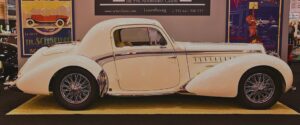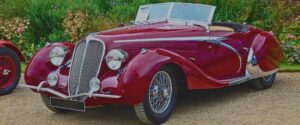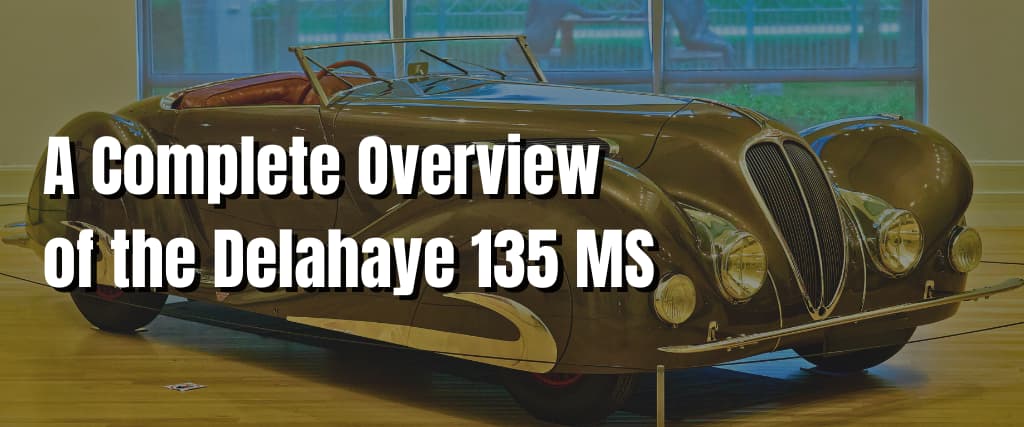Throughout automotive history, some cars have become more than just a means of transportation. They have become enduring symbols of craftsmanship, elegance and performance. The Delahaye 135 MS is one of these remarkable classics, born in the heart of France during the 1930s. It embodies a unique blend of artistry and engineering, which makes it an automotive masterpiece that continues to capture the hearts of enthusiasts and collectors alike.
This article takes you on a journey through time, exploring the rich tapestry of the Delahaye 135 MS’s history, design, engineering and lasting legacy. From its early beginnings in a French industrial town to its successful racing victories and its role as a symbol of post-war optimism, the story of the Delahaye 135 MS is a testament to the enduring allure of French automotive excellence.
So please join us as we explore the distinct characteristics that make the Delahaye 135 MS a classic beauty which transcends the confines of its era, a timeless work of automotive artistry.
The Birth of Delahaye

The Delahaye marque traces its roots back to the 19th century when Émile Delahaye, an engineer, founded the company in Tours, France, in 1845.
The company initially focused on producing industrial machinery, including stationary engines and hydraulic systems. By the turn of the 20th century, Delahaye shifted its focus to automobiles, reflecting the growing popularity of motorised transportation.
Delahaye produced its first automobile in 1895, which marked the beginning of a long and storied journey in the automotive industry. The company gained recognition for its innovative and reliable vehicles and by the 1930s, Delahaye had developed a reputation for building exceptional luxury and sports cars.
Introduction to the Delahaye 135
The Delahaye 135 was a pivotal model for the company – representing the pinnacle of its automotive craftsmanship.
Introduced in the mid-1930s, the 135 was available in various configurations, catering to a broad spectrum of buyers with varying tastes and preferences.
The 135 MS Variant
Within the Delahaye 135 lineup, the MS variant is one of the most remarkable and iconic versions.
The ‘MS’ in the name stands for ‘Modifié Spéciale’, which translates to ‘Special Modified’ in English. This designation hinted at the performance improvements and unique features that set it apart from other models.
Design Excellence
One of the most striking aspects of the Delahaye 135 MS is its sleek design which features a long, sweeping hood, curvaceous fenders and a beautifully streamlined body – embodying the quintessential elegance of the French automotive design of the era.
In particular, the iconic teardrop-shaped fenders are a hallmark of the Delahaye 135, enhancing its aesthetic appeal.
This design was executed by Joseph Figoni and Ovidio Falaschi and is a testament to the mastery of French coachbuilding.
Craftsmanship and Customisation
Delahaye was renowned for its commitment to craftsmanship and the ability to tailor each car to the customer’s desires.
Buyers could choose from an array of body styles, paint colours and interior trim options. This level of customisation was a testament to Delahaye’s dedication to delivering a personalised luxury experience.
Technical Specifications

The Delahaye 135 MS boasts impressive technical specifications – particularly when it comes to its engine, transmission, chassis and suspension and overall performance.
Engine
At the heart of the Delahaye 135 MS lies a potent powerplant. It’s equipped with a 3.6-litre inline-six engine that is supercharged.
This engine is capable of producing around 160 to 180 horsepower, depending on the specific variant and tuning. The supercharger not only increased power but also enhanced the car’s performance – making it a capable sports car of its time.
Transmission
The Delahaye 135 MS typically featured a Cotal electromagnetic four-speed gearbox, offering smooth and precise gear changes. This transmission contributed to the car’s reputation for being a joy to drive.
Chassis and Suspension
The car’s chassis was crafted using lightweight materials to maximise performance and agility.
The suspension system – featuring independent front suspension and a live rear axle – was well-tuned for a comfortable and composed ride.
Subsequently, this combination of a lightweight chassis and advanced suspension made the Delahaye 135 MS competitive in both racing and everyday driving.
Performance
The performance of the Delahaye 135 MS was truly remarkable for its time. It could accelerate from 0 to 60 mph in under 10 seconds, and its top speed ranged from 100 to 120 mph – depending on the specific configuration and tuning.
These figures solidified the Delahaye 135 MS as a sports car with an exhilarating driving experience.
Racing Success
The Delahaye 135 MS achieved legendary status in motorsports – particularly at the 24 Hours of Le Mans.
In 1938, a Delahaye 135 MS, driven by Eugène Chaboud and Jean Trémoulet, secured an overall victory at the prestigious endurance race. This triumph elevated the reputation of the car and the brand, solidifying Delahaye as a force to be reckoned with in motorsport.
In addition to its Le Mans victory, the Delahaye 135 MS succeeded in various other races and rallies, including the Monte Carlo Rally. Its competitive edge and elegant design made it a sought-after choice for racing enthusiasts of the era.
The Post-War Era
The years following World War II brought numerous challenges to the Delahaye company. The economic and social changes that followed the conflict and the growing popularity of American cars posed difficulties for the French automaker. Delahaye struggled to regain its pre-war prestige and market share.
Despite the post-war challenges, the Delahaye 135 MS symbolised French automotive excellence. Today, these cars are highly sought after by collectors and enthusiasts alike. Their rarity and historical significance make them prized possessions among classic car aficionados.
The End of an Era
As the 1950s progressed, Delahaye faced increasing financial difficulties. The company’s struggle to adapt to the changing automotive landscape ultimately led to its decline.
In 1954, Delahaye merged with Hotchkiss, another French automaker, forming Société Hotchkiss-Delahaye. This marked the end of the independent Delahaye company.
Although Delahaye ceased to exist as a standalone brand, its influence on the automotive world endured. The Delahaye 135 MS, in particular, left an indelible mark on the industry, inspiring future generations of designers and symbolising classic French automotive artistry.
Collectibility and Value
The Delahaye 135 MS remains highly sought after in classic cars. Its rarity, racing pedigree, and timeless design contribute to its enduring popularity among collectors.
The auction market for Delahaye 135 MS models has seen impressive results. Some pristine and historically significant examples have fetched seven-figure prices at prestigious events like the Pebble Beach Concours d’Elegance and the Amelia Island Concours.
Given their historical significance and the desire to preserve these automotive works of art, many Delahaye 135 MS vehicles have undergone meticulous restorations. These restorations often involve returning the cars to their original factory specifications, reviving their timeless beauty and performance.
Overall, the Delahaye 135 MS has retained its value and appreciated significantly over the years. This makes it an attractive investment for collectors who appreciate the blend of design, craftsmanship, and historical significance.
Notable Delahaye 135 MS Examples

Many of the most celebrated Delahaye 135 MS examples featured custom coachwork by renowned design houses like Figoni et Falaschi. Their striking and aerodynamic body designs have become iconic in the classic car world. Notable Figoni et Falaschi-bodied Delahaye 135 MS cars include the ‘Narval’ and ‘Vutotal’ – both celebrated for their unique aesthetics.
One of the most collectable Delahaye 135 MS examples is the 1937 Delahaye 135 MS Roadster, often referred to as the ‘Nostalgia’. With its elegant coachwork by Figoni et Falaschi, this remarkable car features an art deco-inspired design that epitomises the era’s sense of luxury and style.
Another iconic Delahaye 135 MS is the 1938 Delahaye 135 MS Coupe, known for its distinctive teardrop-shaped fenders and graceful curves. This coupe boasts an aerodynamic design, representing the best of 1930s French coachbuilding and is a highly sought-after collectable.
The Enduring Legacy
The Delahaye 135 MS isn’t merely an automotive artefact; it’s a cultural icon that symbolises an era of design and craftsmanship that continues to inspire artists, designers and automotive enthusiasts. Its timeless elegance and racing successes have left an indelible mark on the world of classic cars.
The design language of the Delahaye 135 MS has had a lasting influence on the automotive industry. Many modern car designs draw inspiration from its graceful lines, distinctive fenders and aerodynamic shapes. Its enduring appeal underscores the importance of classic cars in shaping the evolution of automotive design.
While the original Delahaye company may have merged and faded away, the legend of the Delahaye 135 MS lives on. Its presence in museums, private collections and automotive events ensures that this classic car will continue to be celebrated for generations ahead.
Conclusion
The Delahaye 135 MS is a testament to the artistry and engineering of the classic automotive world.
Born in an era of innovation, it transcends its time – becoming a symbol of elegance and performance. Its racing victories at Le Mans and its enduring influence on design underline its significance in the automotive pantheon.
As one of the most coveted and collectable classic cars, the Delahaye 135 MS continues to captivate the imaginations of enthusiasts and collectors. Its rarity, racing history and timeless design make it a symbol of French automotive excellence that will always have a special place in the hearts of those who appreciate automotive artistry.


